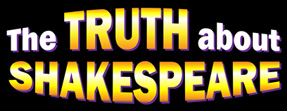Freemasonry and Francis Bacon the Spear Shaker
Inspiration is so interesting, I found myself following a thread which lead me back to Francis Bacon. I felt enlightened.
This is an excerpt…
“…In laying the foundation of a Rosicrucian society, Bacon took measures to insure that the Movement would serve the purpose of helping to build and spread his Great Instauration.
However, his greatest concern for the society was that its spiritual philosophy should always remain secular, avoiding the temptation of becoming a religion. He understood that all religions begin with a spiritual philosophy expounded by a charismatic leader around whom people rally—eventually degenerating into a cult of personality in which the personality becomes the focal point while the spiritual philosophy is relegated to virtual obscurity. To insure that Rosicrucianism wouldn’t become Baconism, Bacon invented a mythical Rosicrucian founder whom he dubbed Christian Rosenkreutz…
Another aspect… “This new Order of Masonry differs from the old Operative Masonry as it is strictly dedicated to building the character of men through the application of philosophical ideals and principles rather than building stone structures.”
Character of men is crucial for transforming our world into one where it reharmonises.
http://thetruthaboutshakespeare.com/index.php/the-real-truth-about-the-freemasons
THE TRUTH ABOUT THE FREEMASONS
By Richard Allan Wagner
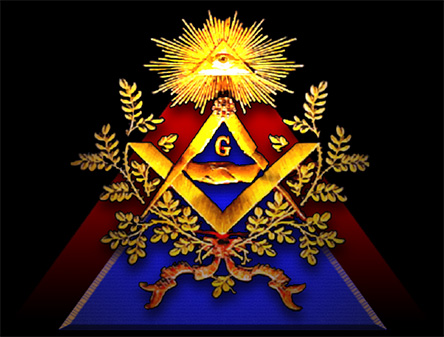
Hopefully you have come to this essay because you’re truly interested in the history and meaning of Freemasonry.
If, however, you’re looking for another Masonic conspiracy theory, you’ve come to the wrong place.
TRUE, this article is uniquely different from all of the rest…
but I must warn you that it reveals truths and facts about Freemasonry that most Masons simply do not know. In fact, the information contained here is radically different from everything average, garden variety Masons are taught or understand.
How can that be?
Well, let’s just say that the VAST MAJORITY of Masons are extremely (and blissfully) ignorant of their “Masonic Heritage”.
You see, most Masons are in the “Fraternity” for the purpose of belonging to a “Good Ol Boys Social Club”, which is perfectly fine, but that’s basically it.
Now understand, I’m not here to put Freemasonry down, after all, I’m a Mason.
Actually, I’d like nothing more than to see Freemasonry receive a much needed jolt to its lethargic and virtually dormant mindset so as to awaken it from its current slumber. Also understand that just reading all of the books and online articles about Freemasonry will NEVER deliver a thorough understanding of it.
IF YOU’RE NOT A MASON, I guarantee you cannot possibly understand what it’s all about—YOU HAVE TO BE ONE IN ORDER TO GET THE COMPLETE PICTURE.
However, if you’re not a Mason this essay will still provide crucial insight into the True meaning of Freemasonry.
Having said all that, let’s get to it…
because what you’re about to learn (whether you’re a Mason or not) is THE REAL TRUTH ABOUT THE ORIGIN OF SPECULATIVE FREEMASONRY.
How and Where Did It All Begin?
Ask any Mason the above question and he’ll likely tell you that (in accordance with “Masonic tradition”) it all began (a) with the building of King Solomon’s Temple, and (b) Masonic knowledge was somehow transmitted over a vast time to take root in the “operative” stone masons guilds of medieval Europe—culminating in the founding of the English Grand Lodge of “Free and Accepted Masons” in 1717.
Some Masons will even go so far as to allude to extremely vague words, names and phrases from the Old Testament in a vain attempt to legitimize the claims of “Masonic tradition”.
The problem with “Masonic tradition”, however, is that it rests on supposition rather than historical fact—starting with the mythical story of Hiram Abiff who, according to Masonic tradition, was the “Grand Master” architect who oversaw the construction of King Solomon’s temple.
Of course there’s no historical, archeological or even biblical evidence to support the Hiramic myth.
And yet, this myth is the centerpiece for the traditional view of the origin of Freemasonry and its fundamental meaning.
Freemasonry has always referred (unofficially) to various ancient esoteric schools of thought as the foundation of its philosophical tenets.
Among these are Egyptian Hermeticism, the Pythagorean-Orphic mystery schools, and the Jewish Kabbalistic tradition.
But none of them make any mention of Hiram Abiff.
Furthermore, the “Regius poem”, AKA the “Halliwell Manuscript” (circa 1390) is understood to be the oldest genuine record of the “Masonic Craft” known to exist.
Yet it says absolutely nothing of Hiram Abiff or the building of King Solomon’s temple.The glaring lack of evidence to support the existence of the Hiramic myth by the early fifteenth century is only too obvious.
Clearly, the story of Hiram as the founder of Freemasonry hadn’t yet been conceived—who invented him, and why?
Enter Francis Bacon
Over the centuries, the personal details of the lives of many great historical figures have been obscured, distorted or deliberately swept under the carpet.
Such is the case with Francis Bacon.
As extraordinary as it may seem, there is an avalanche of hard, tangible evidence that supports the following:
(a) Francis Bacon was a secret son of Queen Elizabeth I—which made him an heir to the Tudor throne, and
(b) he was the genius behind the creation of the collective works ascribed to the literary name “William Shakespeare”, and
(c) he was the creator of modern “Speculative Freemasonry” along with the Hiramic myth.
I realize that, for many people, this information may seem like a bizarre pill to swallow.
For those who are not already familiar with these facts, see the specific details and hard evidence set forth in my book The LOST SECRET of William Shakespeare @ www.thelostsecretofwilliamshakespeare.com).
READ ON
The Rosicrucian Movement and its Impact on Bacon and Freemasonry
Some eighty three years prior to the writing of the Regius Poem (which basically provided a constitutional outline for early Masonic philosophy and principles) the medieval Order of the Knights Templar had been viciously attacked and torn asunder by the Catholic Church.
The surviving members of the Order scattered throughout Europe seeking refuge in secret underground enclaves.
The Church had declared an all-out war against all progressive scientific and philosophical thinking deemed to deviate in the slightest degree from Catholic dogma—the great inquisition had arrived.
Those who were accused of, or believed to be harboring heretical beliefs were condemned to be burned alive at the stake. As a result, most of Europe’s leading minds became members of a loosely knit secret society generically known as the “Invisible College” or the “Great Society”—but in truth it was the precursor of what would become the Rose Croix or Rosi Cross Order (the Rosicrucians).
Ironically, this secret underground movement, which made great advances in the arts and the sciences, was unwittingly sponsored by rich patrons of the Church—indeed by the Church itself—all under the guise of producing religious art.
The underground “Rosicrucian Movement” became the exact cause of the Italian Renaissance. Great Renaissance masters such as Da Vinci and Michelangelo took special delight in secretly thumbing their noses at the Church by hiding heretical esoteric messages in their work.
The flow of esoteric thinking that bridged the latter part of the sixteenth century into the seventeenth century brought about the intellectual explosion of the English Renaissance, which spawned revolutionary innovations in literature, science and social philosophy, with Francis Bacon as its supreme architect.
He would fuse the Rosicrucian and Masonic esoteric traditions together, raising them to a new synthesis of knowledge and understanding that hadn’t been seen before.
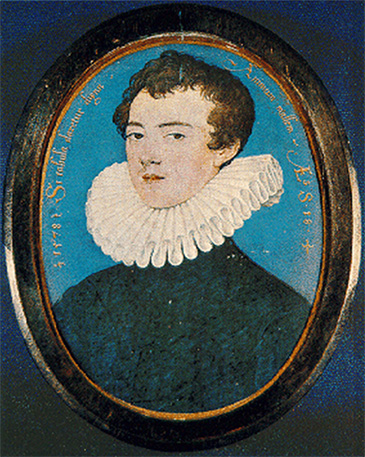
Francis Bacon at the age of seventeen
In the late 1500’s, Dr. John Dee was widely recognized as the preeminent authority on all esoteric knowledge. Additionally, he served as one of Queen Elizabeth’s chief spies.
Furthermore, as a mentor to the prodigious young Francis Bacon, Dee’s influence was immense.
By his early teens, Bacon, with his stellar mind, had far surpassed everything England’s leading educators and scholars could possibly throw at him.
For the world, Bacon was already an intellectual force to be reckoned with. Dee’s guidance helped to shape what the French would refer to as “the jeweled mind”.
The Rosicrucian light was handed from one master to another.

Jacob Cat’s engraving (titled “Lampado Trado”) shows John Dee
passing the lamp of Rosicrucian light to Francis Bacon over an open grave
The “Great Instauration”, Bacon’s Grand
Masonic Plan for the Enlightenment of Humanity
In 1593, Bacon wrote: “I claim all knowledge to be my province”.
He wasn’t joking.
As far as he was concerned, all of the classical knowledge, wisdom, science and literature of ancient Greece and Rome had died out long before his time, only to be buried and left like a rotting corpse to decay—lost to the ages. Bacon would spend the rest of his life laboring at something he called his “Great Instauration”—a highly ambitious and dynamic plan to restore the decayed knowledge and wisdom of the classical past—then take it all to soaring new heights. The “Instauratio Magna” would serve as the foundation upon which Bacon, with the assistance of his “Fra Rosi Cross” brethren, would create an entirely new way of thinking that would have a dramatic impact on all future human endeavor.
The implementation of the Great Instauration first required organization and structure.
Until Bacon took hold of the reins of the Rosicrucian Movement, it had lacked any semblance of cohesion or direction. Early on, young Bacon understood the need to transform the primitive and deficient English Language into a dynamic medium that would be capable of conveying highly sophisticated ideas in the same manner as the classical Latin Language.
Bacon further understood that the most efficient way to disseminate a new English Language to the illiterate masses was to unleash it through the sheer power of the theater.
To that end, he devised a new form of play writing inspired by his adopted muse, the Greek goddess Pallas Athena, AKA “The Spear Shaker”.
The first “Shakespearean” work, Venus and Adonis, was published anonymously.
Then, as other poems and the plays began to unfold, the pseudonymous name of “Shake-Speare” or “Shakespeare” began to emerge. In order to better understand why the name “Shakespeare” ascribes to Bacon’s muse Pallas Athena (the Spear Shaker) and NOT the man from Stratford, refer to Chapter 1 of The LOST SECRET of William Shakespeare at www.TheLostSecretOfWilliamShakespeare.com.
READ ON
For Bacon, Rosicrucianism and Freemasonry were intricately related.
In fact, Rosicrucian and Masonic philosophies are essentially the same.
Moreover, both traditions share many common symbols and metaphors—and furthermore, both traditions made use of the rich new language engendered in the Shakespearean canon. By all accounts, the Shakespearean works introduced thousands of new words into the English Language. By design, the sumptuous language of Shakespeare was the perfect vehicle for espousing Masonic-Rosicrucian principles and ideology (see Chapter 23 of The LOST SECRET of William Shakespeare).
By the age of fifteen Bacon was thoroughly schooled in Rosicrucian ideology and he had begun work on a project he would eventually call The Advancement of Learning.
Aside from Shakespeare, this would be a life long labor. The Advancement of Learning emphasized a new line of scientific reasoning Bacon referred to as natural philosophy—years later it would all morph into his seminal work the Novum Organum which laid the foundation for the modern inductive scientific method. But at fifteen, Bacon wasn’t yet a Mason.
One morning in late 1576, Queen Elizabeth packed young Bacon up and personally shipped him off to France.
Her reason for such action may well have been prompted by Bacon’s discovery of his royal parentage. Whatever the reason, Elizabeth definitely wanted young Bacon out of her hair. Moreover, she also wanted him to get a good dose of what life was like abroad—and she wanted him to spy on foreign governments and officials in the same capacity as John Dee. Under Dee’s tutelage, Bacon had already learned how to weave coded cipher messages into all of his correspondence and writing. Eventually, he would invent newer ways to transmit ciphered messages.
At the age of seventeen, Bacon was initiated into the Order of Operative Masonry.
In earlier years, the Operative Masons had been the builders of Europe’s grand cathedrals. Because of their affiliation with the defunct Knights Templar, they were as much at odds with the Church as the rest of the underground movement. The only way they could maintain their existence was to “ACCEPT” affluent noblemen who had NO experience or background in the craft of stone masonry into their ranks. Like all Operative Masons before them, “accepted Masons” were allowed to choose a symbolic mark that would individually distinguish them from all others. To this very day, we can easily view the personal identifying marks of real Operative Masons chiseled in the stone blocks of Europe’s towering cathedrals Bacon created his own mark, then deliberately flaunted it in his 1597 French publication of his Advancement of Learning.
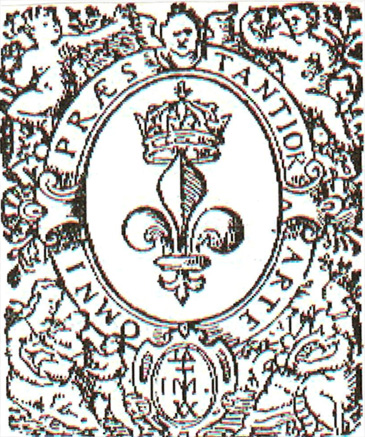
The bold front cover page of the 1597 French publication of
The Advancement of Learning in which Bacon’s Masonic “I M” mark is displayed
The audacious 1597 French publication of The Advancement of Learning is significant for two essential reasons:
(a) in the large, center oval, the Fleur-de-lis, crowned with a coronet, is prominently displayed—an important symbol of the Prince of Wales (heir to the English throne), and
(b) beneath the Fleur-de-lis rests a smaller oval (similar to an Egyptian cartouche).The letters I M are wedged between the Masonic “Triple Tau” and “Square and Compass” symbols. I M was Bacon’s personal Operative Mason’s mark signifying “I AM” an Operative Mason. Many years later, he would jokingly write an enigmatic eulogy to himself (as Shakespeare) in the 1623 Shakespeare Folio, signing it with his Masonic I M signature.
READ ON
The Invention of Christian Rosenkreutz and Hiram Abiff
Upon John Dee’s death in 1609, Bacon had become the towering figure in the Rosicrucian Movement.
Yet the Movement still lacked leadership and organization. However, in 1611, Michael Maier, the German Rosicrucian master, who in earlier years had become acquainted with Bacon through Dee, came to London for two basic reasons. First, the new English Language being created by Bacon and his Fra Rosi Crosse society was rich in Rosicrucian-Masonic symbolism, and Maier hungered to digest it. To that end (according to Rosicrucian tradition) Maier, who possessed no official authority, proffered the unprecedented position of Rosicrucian Imperator to Bacon, who humbly accepted.
In laying the foundation of a Rosicrucian society, Bacon took measures to insure that the Movement would serve the purpose of helping to build and spread his Great Instauration.
However, his greatest concern for the society was that its spiritual philosophy should always remain secular, avoiding the temptation of becoming a religion. He understood that all religions begin with a spiritual philosophy expounded by a charismatic leader around whom people rally—eventually degenerating into a cult of personality in which the personality becomes the focal point while the spiritual philosophy is relegated to virtual obscurity. To insure that Rosicrucianism wouldn’t become Baconism, Bacon invented a mythical Rosicrucian founder whom he dubbed Christian Rosenkreutz.
To further heighten the mystique about his Rosenkreutz alter ego, Bacon made sure that his legendary creation had departed the world some two centuries earlier after supposedly founding the Rosicrucian order in 1407.
Upon his demise, Rosenkreutz was quite conveniently laid to rest in a mysterious seven sided tomb—the location of which was never to be revealed.
The second decade of the seventeenth century saw the publication of three successive “Rosicrucian Manifestos”, i.e. the Fama Fraternitatis (1614), the Confessio Fraternitatis (1615), and the Chymical Wedding of Christian Rosenkreutz (1616).
Although the three manifestos had been written anonymously, they clearly have Bacon’s fingerprints all over them. The Rosicrucian Movement had finally been given a stated purpose which bore an uncanny resemblance to Bacon’s Great Instauration—along with a blueprint for the establishment of a Rosicrucian utopia. Indeed, the Confessio Fraternitatis was a precursor to Bacon’s later work, titled The New Atlantis.
With the Rosicrucian manifestos out of the way Bacon turned his attention toward transforming his Fra Rosi Crosse society (which consisted of a select few friends and scriveners who assisted him in the production of the Shakespearean works) into a new form of Masonry that would eventually become known as “Speculative Freemasonry”.
This new Order of Masonry differs from the old Operative Masonry as it is strictly dedicated to building the character of men through the application of philosophical ideals and principles rather than building stone structures.
As had been the case with Christian Rosenkreutz, Masonry needed a mythical founder of its own, and voila, Hiram Abiff was born.
As we shall see, neither the names of the two mythical founders nor the founding years of 1407 and 1617 were accidental.
Bacon’s use of ciphered messages pervaded virtually everything he wrote.
His application of complex cipher techniques such as his bi-lateral cipher and his wheel cipher that he discusses in The Advancement of Learning remain a mystery insofar as the extent of their possible utilization throughout his works. However, Bacon clearly made extensive use of the Pythagorean, Kaye, Simple, Reverse and Short cipher tables. For example, both of the names Rosenkreutz and Hiram Abiff correspond to the number 55 in the Pythagorean table. And with regard to the year 1407, Bacon playfully invites us to look at the number in reverse—rendering the number 7041, or rather the numbers 70 and 41. When combined they add up to the important Kabbalistic number 111, which serves as one of Bacon’s favorite cipher signatures as it corresponds (in the Kaye Cipher) to the name Bacon. As we shall see, the number 111 shows up consistently throughout the pages of Shakespeare.
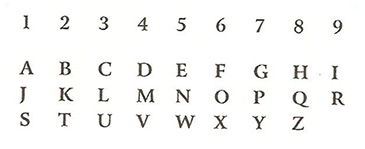
The Pythagorean Cipher Table
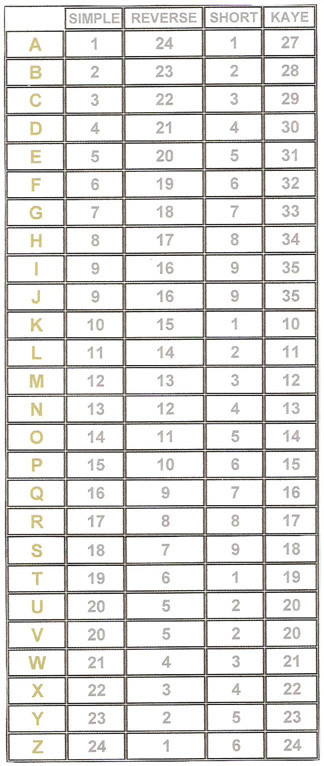
The Elizabethan Simple, Reverse, Short and Kaye Cipher Tables
THE PLOT THICKENS – READ ON
Bacon’s Cipher Signatures
The mythical founding of the Rosicrucian Order in the year 1407 is also important because it occurs exactly 100 years after the destruction of the Knights Templar.
For Bacon 100 was an ideal cipher number for representing his full name in accordance with the Elizabethan Simple Cipher table, i.e. Francis = 67, and Bacon = 33 (another important signature number).
Furthermore, he often used the Roman numeral “C” (lunate sigma) as code for his full name—thus, we find the number “C” branded on the side of a boar that is prominently displayed at the top of Bacon’s coat of arms.

Bacon’s Coat of Arms
It should come as no surprise that Bacon alludes to the boar’s C brand in Shakespeare Sonnet 111: “Thence comes it that my name receives a brand”.
Also not surprising is the fact that the Fama Fraternitatis tells us that the founding brothers of the Rosicrucian Order were to meet on day C (day 100) of every year—additionally they were to keep the existence of their Order a secret for exactly 100 years.
Thus, Rosicrucian tradition carried over into Bacon’s ostensible founding of Speculative Masonry (1617) as we find the new Masonic Order emerging from secrecy in 1717.
There was another significant reason why the number 100 was crucial to Bacon’s secret identity.
Not only does 100 represent the name Francis Bacon, it also corresponds to the name Tudor in the Elizabethan Kaye Cipher table.
But it doesn’t stop there, the name Francis Bacon also adds up to the number 51 in the Pythagorean Cipher table while the name Tudor renders 51 in the Elizabethan Reverse Cipher.
Bacon devised many clever ways to use his signature ciphers with regard to Shakespeare and Masonry.
One technique involved the application of cipher only to the first letter of certain words or names in various word combinations and phrases. For example, the name William Shakespeare and the Masonic expressions Widow’s Son (referring to Hiram Abiff) and Winding Stair (an allegorical feature of King Solomon’s Temple) all share the initials W S. In the Pythagorean table the letter W = 5 while the letter S = 1—thus, WS can be viewed as 51 (Francis Bacon).
While the numbers 100 (in accordance with the Simple Cipher) and 51 (in accordance with the Pythagorean Cipher) serve as code for Bacon’s full name, as well as the name Tudor (Kaye and Reverse Ciphers), Bacon generally used cipher numbers that represented his last name.
As we’ve already seen, the number 111 (Kaye Cipher for Bacon) and the number 33 (Simple Cipher for Bacon) were widely favored by him. However, Bacon occasionally used the numbers 15 (Short Cipher) and 17 (Pythagorean Cipher) to represent his last name.
Ben Jonson and Shakespeare’s Connection to Masonry
In the late years of his life, Bacon employed the playwright Ben Jonson as his secretary.
Jonson also lived with Bacon at Gorhambury.
In addition to assisting in the production of the Shakespearean works, there is ample evidence to suggest that Jonson became one of Bacon’s early Speculative Masons. One highly compelling clue pointing to Jonson as a Mason is the headpiece that appears above his mysterious eulogy of a supposedly deceased Shakespeare in the 1623 Shakespeare Folio. The headpiece consists of a contiguous row of upright mason’s squares. To this day, the square is the insignia worn by the “Worshipful Master” of a Masonic blue lodge. The row of squares in the headpiece actually spell out the letters WM twice. As all Masons know, the letters WM are shorthand for Worshipful Master. Was the headpiece alluding to Ben Jonson as a Worshipful Master? Whatever the purpose of the headpiece was, its symbolic connection to Masonry is undeniable.

The Masonic headpiece above Ben Jonson’s eulogy in the 1623 Shakespeare Folio
As a code device, the headpiece strongly suggests a connection to Bacon (the original Worshipful Master) for the following reasons:
(a) the letters WM add up (in both the Kaye and Simple Ciphers) to the number 33 (Bacon, Simple Cipher), and
(b) the word “Worshipful” corresponds (Reverse Cipher) to the number 111 (Bacon, Kaye Cipher). To this day, all Worshipful Masters and Past Masters proudly carry the title of Worshipful, followed by their last name.
In his eulogy, Jonson makes it quite clear that he is well acquainted with the author of the Shakespearean work, whom he refers to as “My beloved”.
But the most intriguing clue to the author’s identity is in Jonson’s cryptic reference to “Sweet Swan of Avon” Once again the answer to the riddle rests with the first letter in each word, i.e. S S O A. Sure enough, these letters add up (Simple Cipher) to 51 ( Francis Bacon, Pythagorean Cipher).

Ben Jonson
Mingling Ciphers
As far as the “intermixing” of ciphers go, Bacon seemed to prefer using as many variations as possible, provided they were understandable.
There are many scenes in the Shakespeare plays that offer up a rich blend of coded messages and meanings using different cipher techniques. In Scene 1, Act IV of Macbeth, the lead witch, Hecate, sings a rhyming riddle:
“Black spirits and white, red spirits and gray;
Mingle, mingle, mingle, you that mingle may.”
Hecate’s riddle begins by directly identifying the four colors that comprise Bacon’s family crest (black, white, red and gray).
The riddle consists of 15 words.
15 = Bacon (Short Cipher).
And the word “Mingle” adds up to 33 (Pythagorean Cipher).
As we’ve seen, 33 = Bacon (Simple Cipher).
By design, Bacon is everywhere in the riddle. But more important is the fact that we (“that mingle”) are being instructed to mingle, i.e. mingle ciphers.
If that were not enough, the preceding “double, double toil and trouble” chant of the three lesser witches, has three different lines that begin with the words “Fire burn”. It’s no accident that the letters F b are Bacon’s initials.
But, to make sure we understand that this is a reference to the name Francis Bacon, we “who mingle” clearly see that the words “Fire burn” add up (Reverse Cipher) to the number 111 (Bacon, Kaye Cipher).

Bacon’s Family Crest
Why the Worshipful Master Wears a Top Hat
When performing ritual in the blue lodge, the Worshipful Master always wears a top hat.
But ask him why… his answer most likely will be: “this is the way we’ve always done it”. And he’d be right, or rather he’d be partly right. The part of his answer that would be missing is that, in wearing the top hat, he is emulating the original Worshipful Master Francis Bacon. Most men during Bacon’s time wore hats, but he wore a distinctly unique style of hat called the high hat. He adopted the custom of wearing the high hat for the purpose of distinguishing himself as the Worshipful Master. In virtually every portrait and engraving of Bacon, we see him wearing his high hat.
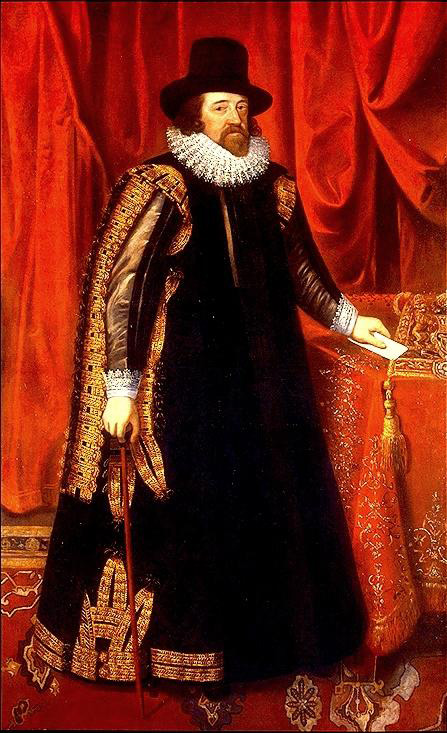
Francis Bacon Wearing His Worshipful Master’s High Hat
Masonic Spear Shakers
During the performance of ritual there are four blue lodge officers who carry spears.
These are the Senior and Junior Deacons, and the Senior and Junior Stewards. Ask them why they carry the spears and they’ll likely shrug their shoulders and tell you “this is how we’ve always done it”. In other words, they don’t understand the true symbolic meaning behind the ritual. In fact, over the years, the spears gradually came to be referred to as “rods”. However, a long shaft or pole capped with a pointed metal tip is still a spear, no matter how you look at it.
As mentioned earlier, the name Shakespeare was inspired by Bacon’s adopted muse, the Greek goddess Pallas Athena, AKA “the Spear shaker”.
It’s important to note the idea that the Stratford man’s name was Shakespeare is false. His actual name was Shaksper (pronounced shack spur). There is no evidence that his name was ever pronounced or spelled as Shakespeare.
Pallas Athena was the goddess of wisdom and justice.
The ancient Athenians erected a statue of her on top of the Acropolis. She held a spear in her right hand and a crystal shield with her left hand. At certain times of the day, the sunlight reflected off her spear in such a way as to give the appearance that she was shaking it—hence the nickname “Spear Shaker”. Bacon thought of his Spear Shaking muse as the embodiment of his higher and nobler self—particularly with regard to his poetic literary pursuits, which he either wrote anonymously or pseudonymously.
In choosing the ultimate pseudonym, Bacon put the words Shake and Spear together, then added the extra letter “E” on the end so that name Shakespeare would add up (in accordance with the Simple Cipher) to the number 103.
By ignoring the zero as a null or “non-significant” number, the true result is the number 13. Bacon wanted 13 to be Shakespeare’s number for two essential reasons: (a) it’s the most significant prime number in the Fibonacci Sequence (See Chapter 39 of The LOST SECRET of William Shakespeare), and (b) Pallas Athena’s code number was 104 (Simple Cipher). By combining 103 with 104 we get 207 or 27. 27 was another important number for Bacon. Shakespeare Sonnet 103 is specifically addressed to Pallas Athena as the personification of Shakespeare.
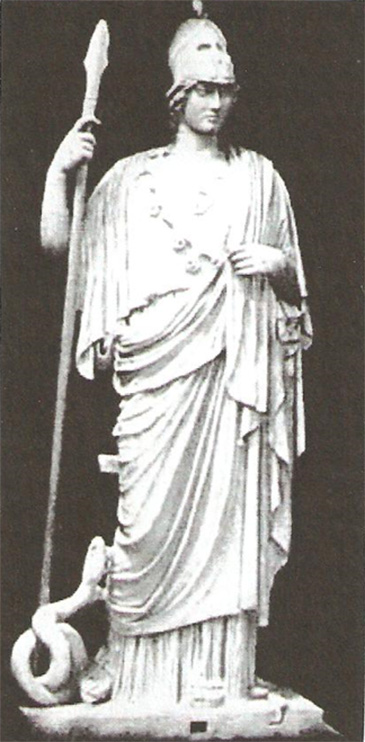
The goddess Pallas Athena-the Spear Shaker
Pallas Athena’s essence was infused into Speculative Masonry.
The statue in the above picture shows Pallas Athena using her spear to stamp out the serpent of ignorance. This became a symbolic cornerstone for both the Great Instauration and Speculative Masonry. For Bacon the act of “spear shaking”, i.e. the act of ridding humanity of the corrupt and pernicious effect of ignorance constitutes the foundation of his Great Instauration. Thus, the four Masonic lodge officers who carry (shake) spears are charged with the duty of preparing and guiding all “Candidates” for and through their initiatory education in the three Masonic blue lodge degrees. To that end, these four spear shaking officers exemplify the enlightening spirit of Pallas Athena.
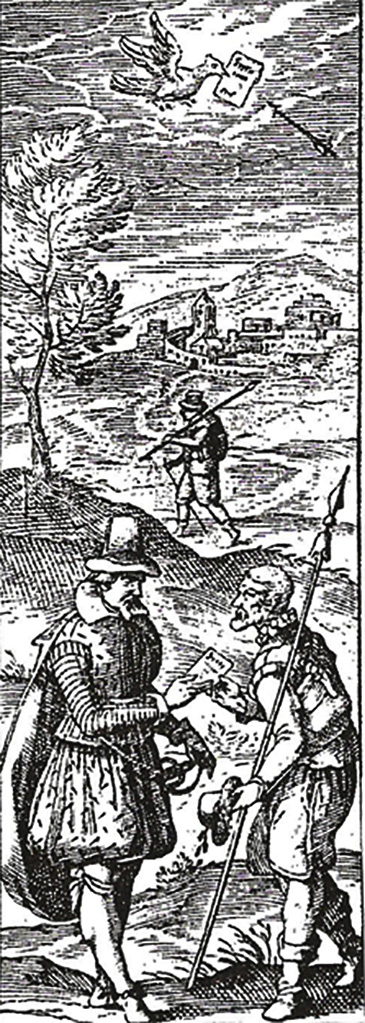
Engraving by Gustav Selenus showing Worshipful Master Bacon
Handing a Message to His Senior Deacon.
The Junior Deacon walks in the distance.
Notice the position of Bacon’s feet.
The Position of the Candidate’s Feet
In both the Masonic First and Second Degrees, the Candidate is instructed to place his feet together so as to form a “right angle”.
This tradition originated with Bacon. The greater meaning of the stance is that the feet are forming the letter T. The letter T stands for Tudor, AKA Francis Bacon.
The Letter “G”
In all Masonic blue lodges a capital letter “G” is mounted or suspended directly above the Worshipful Master’s chair.
This is another tradition originated by Bacon. If you ask a Mason to explain the meaning of the letter ”G” he’ll probably tell you that it stands for God or Geometry, or both. However, Bacon’s used the letter “G” as a cipher device.
The Duke of Clarence’s opening speech in Scene I of Act I of the Shakespeare play Richard III is an excellent example of Bacon putting on a remarkable display of the use of the letter “G” as a cipher device.
Throughout the text Bacon has carefully arranged three separate G letters in a strategic manner so that they form the points of the familiar “bride’s chair” triangle of the famous Pythagorean Theorem (an important Masonic symbol). In this case, each of the G letters correspond to the number 7 (Simple Cipher)—resulting in the important Kabbalistic number 777. However, Bacon’s general use of the letter “G” was for the purpose of displaying his name. Hence (in accordance with the Kaye Cipher) the letter “G” above the Worshipful Master’s chair represents the number 33. And, as we’ve seen, the number 33 = Bacon (Simple Cipher).
How the Word FREE Got Into Masonry
As an important note, prior to Bacon, the word Freemasonry was not in use.
Ask any Mason why modern Masonry is called “Freemasonry”. His answer will go something like:
(a) back in the days when the stone masons guilds were active, Operative Masons were given license to freely cross over international borderlines in order to do their work, and
(b) most Operative Masonic lodges (especially Scottish lodges) required their initiates (Candidates) to be unbridled from the bounds of slavery or servitude.The reason why a prospective Candidate had to be FREE from all forms of slavery, bondage, or servitude was to insure that he was worthy of vowing his solemn oath according to his own free will.
These explanations are correct as far as Operative Masonry was concerned, and they are also correct as they extend into Speculative Masonry.
However, the Masonic use of the word FREE has still a higher meaning.
Like the name Tudor, the word FREE is interchangeable with Bacon’s name. So, once again, the language of Freemasonry is intertwined with the language of Shakespeare as the word “Free” is the final word resting unequivocally as a double signature in the Shakespeare play The Tempest. Hence, the word FREE = 33 (Simple Cipher), and 111 (Kaye Cipher). And so, FREE masonry is in fact BACON masonry.
READ ON
The True Meaning of the Masonic Third Degree
The ultimate goal of the Candidate’s journey through the three Masonic blue lodge degrees is to be “Raised” to the “Sublime Degree of Master Mason”.
It sounds great, but what does it really mean? The Candidate hopefully discovers the true meaning by participating in a staged play in which he is cast in the role of Hiram, and the Hiramic myth is played out.
The Hiramic myth has the Grand Master Hiram Abiff being confronted by three lesser Fellowcraft Masons who tell him they will take his life unless he reveals the secret of the Master Mason.
Being the virtuous man he is, Hiram refuses to give up the secret, whereupon the three “ruffians” known as “Jubela, Jubelo, and Jubelum”(note: three J letters = 111, Pythagorean Cipher) all participate in murdering him. Then they remove his corpse out to the countryside and bury him in a shallow grave, marking it with a tiny sprig from an Acacia tree.
Perplexed by Hiram’s absence King Solomon sends out a cadre of Fellowcraft Masons (all wearing white gloves) to search for their Worshipful Grand Master.
Eventually they discover his shallow grave (marked by the acacia sprig) and dig up his decomposed body. It’s important to note their repulsion of the stench emanating from Hiram’s rotting corpse—this is a crucial theme in Bacon’s tale of the origin of the Great Instauration. In fact, the Hiramic play of the Masonic Third Degree IS AN ENACTMENT OF BACON’S GREAT INSTAURATION!
Upon digging up Hiram’s remains, King Solomon takes hold of Hiram’s dead hand (using the secret grip of the Master Mason) then RAISES him to an upright stance.
A transmutation has taken place as if the noble spirit of Hiram has entered the Candidate’s body—resulting in some sort of apotheosis. Hiram is reborn—the Great Instauration is complete. This newly Raised Hiram is a different person than he was before. King Solomon (Bacon) whispers three words in his ear. These words are a “substitute” for the original lost WORD (knowledge) of the Master Mason. The words themselves are not important but the first letter of each word is of the utmost significance. The letters are M, H, B. These letters are a code—a code for what?
Back to the cipher tables we go.
Two things STAND OUT: (a) M H B adds up (in the Simple Cipher) to the number 22. This number is code for Bacon’s birth date, i.e. January 22, the 22nd day of the year. And (b) M H B also corresponds to Shakespeare’s number 13 in the Short Cipher. Thus, the newly Raised Hiram is reborn in accordance with Bacon’s birth date, and he reemerges as Shakespeare—the spirit of the Great Instauration. The new Master Mason is then ceremoniously given the acacia sprig that had marked his grave. As we shall further see, the uncanny duality between Shakespeare and Hiram Abiff plays out in the Shakespearean works.
The Hiram Abiff – Shakespeare Connection
There’s a lot of Shakespeare in Freemasonry and a lot of Freemasonry in Shakespeare.
An excellent example of this is to be found (appropriately) in Scene 3 of Act 3 in the Shakespeare play Macbeth in which Banquo is murdered in the same manner as Hiram Abiff. But the most compelling display of the Hiram-Shakespeare connection unfolds in the 1640 edition of SHAKE-SPEARES SONNETS. On the cover page, we find the William Marshall engraving—a presumed depiction of Shakespeare. Take a careful look. Notice his left hand is clad in the white glove of the Masonic Third Degree. Furthermore, the gloved hand holds the acacia sprig. Shakespeare is actually being shown as a newly Raised Hiram Abiff.
The highly cryptic “Dedicatory” page for SHAKE-SPEARES SONNETS provides yet another clue to the identity of the man on the cover.
The Sonnets are dedicated to their “Onlie Begetter”, a “Mr. W. H.” also referred to as “OUR.EVER-LIVING.POET”. For centuries people have puzzled over who Mr. W. H. is. Hmmm, who could he possibly be?
If the business with the white glove and the acacia sprig were not enough, we are compelled to go back to the cipher tables. Ah yes, the letters W H add up in the Kaye Cipher to the number 55, and, as noted earlier, 55 = Hiram Abiff (Pythagorean Cipher).
So the answer to the riddle is that “Mr. W.H.” is Mr. Worshipful Hiram.
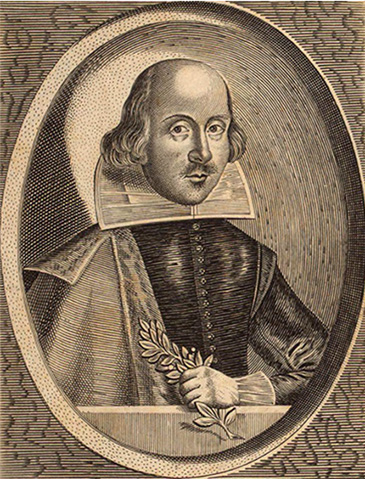
The Marshall Engraving Showing “Mr. Worshipful Hiram”
Notice “Mr. Worshipful Hiram” consists of 17 letters.
As noted earlier, 17 = Bacon (Pythagorean Cipher).
Moreover, the three initials in the name, i.e. M W H add up in the Kaye Cipher to 67 which is code for the name Francis.
To insure we would understand the significance of the 17 letters in the name “Mr. Worshipful Hiram”, Bacon repeated the same coded message with the words “OUR.EVER-LIVING.POET which is also comprised of 17 letters. And, for good measure, Bacon deliberately used a hyphen in the spelling of the book’s title, i.e. SHAKE-SPEARES SONNETS—hence, we have three S letters which then renders the number 111 (Pythagorean Cipher).
Clearly, Hiram Abiff is the centerpiece around which the Shakespeare Sonnets revolve.
Even the number of Sonnets reflect his name, i.e. 154 simplifies to 55. And as a final affirmation of Hiram’s importance, Shakespeare Sonnet 55 is specifically addressed to Hiram Abiff. To insure that we would understand this, Bacon cleverly crafted the Sonnet so that the words masonry and arise (Raise Up) are connected or joined by precisely 55 words. We understand how these two words pertain to the Masonic Third Degree. But more important is the fact that these two key words ONLY appear in Sonnet 55. They are not present in any other Shakespeare Sonnet.
The Meaning of the White Gloves
The Fellowcraft Masons who are charged with the job of digging up Hiram’s decayed body put on white gloves prior to the performance of their duty.
There are two reasons for wearing the gloves.
First, in Masonry, the color white symbolizes innocence and fidelity. The hands that uncover Hiram’s remains must be pure and uncorrupted.
Second, the words White Gloves add up (Pythagorean Cipher) to the number 55, which corresponds to the name Hiram Abiff
The Meaning of the Acacia Sprig
The Acacia tree, which is indigenous to the world’s Middle Eastern region, possess the remarkable ability to dry up and die during periods of severe drought.
Then, when water returns to its roots, it is able to regenerate back to a living state of existence—as if reborn. For this reason a sprig from the Acacia tree is symbolic of immortality. However, there is still a deeper meaning to it. The words Acacia Sprig add up (Pythagorean Cipher) to the number 51, which corresponds to the name Francis Bacon.
Finally, Shakespeare Plus Hiram Abiff Equals Francis Bacon
As we saw earlier, 13 is Shakespeare’s number.
However, there is another number that represents Shakespeare, i.e. 45. Notice that both the name Shakespeare and the word Thirteen correspond (Pythagorean Cipher) to the number 45. Therefore, 45 (Shakespeare) + 55 (Hiram Abiff) = 100 = Francis Bacon (Simple Cipher).
Thus, I conclude my analysis of the true meaning and origin of Speculative Freemasonry.
For more information about Richard Allan Wagner
including his novels, books, and articles, visit:
